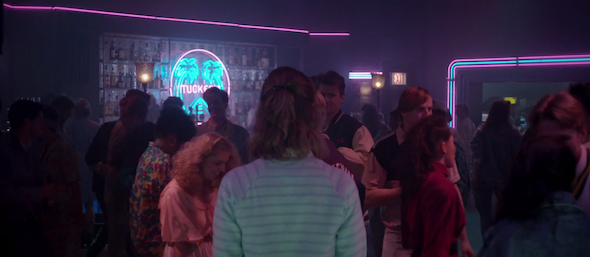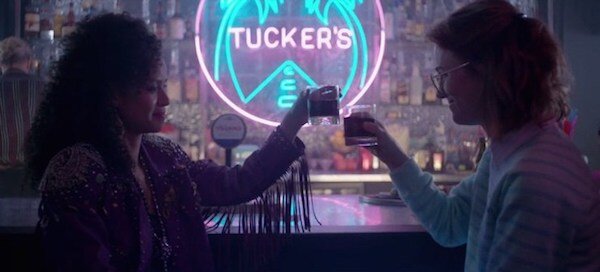Melancholy and euphoria go hand in hand for today’s youth, thrust into a world of always-on bright lights. Cinema reflects reality, too, as neon lights offer a perfect landscape to wrestle through emotional unrest on screen. Taylor Hunsberger writes on the aesthetic phenomenon across Black Mirror and Atlantics.
In 2016, Lorde repopularized an aesthetic reminiscent of the 1980s during her Melodrama album cycle, blending coloured neon lights and synth pop music with transcendental melancholy and mourning. This style is emblematic of the modern world: extreme moments of sorrow are forced to coexist alongside everyday activities and attempts at distraction. Melodrama is the story of a breakup told through the metaphor of a house party: Lorde weaves in and out of the emotions of heartbreak, regret, wistful recollection, and the electric energy of falling in love. She exemplifies fulfilling our every wish by projecting our most difficult feelings into this dissociative dream state, where we can pretend it is happening in a movie instead. In ‘Supercut’, Lorde sings, “We were wild and fluorescent, come home to my heart,” acknowledging her own intentions behind the aesthetic, associating her journey through the dramatic plot structure of the album with the glaring theatrics of neon lights.
As with music, the neon light aesthetic has been brought to the forefront in recent years within film and television, invoking similar ideas of fantasy and wish fulfilment amongst tragedy. These lights are used to stylize scenes in a way that signals to the audience that what is pictured takes place in a world outside the characters’ reality. The present-day twists on neon light are particularly well highlighted in the nostalgic and time-bending love story of the Black Mirror episode “San Junipero”, and the forbidden ghostly romance of Mati Diop’s Atlantics. Both examples make use of a forbidden romantic love plot in order to convey the politics of their narrative, spinning the melodrama genre on its head, but with just as much extreme emotion. These stories find their protagonists coping with rejection, exploitation, and grief, under a neon spotlight.
“San Junipero” throws the viewer into a medically-induced virtual reality, which allows souls to travel through time. After a trial, users are able to let go of their physical forms and live there permanently after death. The episode follows a socially anxious lesbian, Yorkie, to a virtual bar where she meets Kelly, an unrestrained potential love interest. The bar’s neon-lit dance floor serves as a utopia of unapologetic personal expression. The dance floor allows new lovers to meet and mingle in the afterlife, regardless of their previous age or social status. When Yorkie and Kelly meet at the bar, they are washed in flashing magenta and teal from above, and pastel pink and pale blue from neon signs on the walls. They are concealed in a 360-degree spectrum of bright, queer colors.
When an anxious Yorkie runs into the alley after she is seen dancing with another woman by the other people, Kelly follows. Street lights and signs from a burger restaurant and 24-hour motel illuminate an otherwise dimly-lit scene with a color palette featuring vivid primary colors. The difference in the color of the lights indicates that the alley is a space better reflecting our real- world equivalent, rather than the queer euphoria confined to the setting of the bar. This setting triggers Yorkie to roll her shoulders in towards her chest, eyes cast down to the ground, and an anxious half-smile. The familiarity of the location causes Yorkie to revert to the same constraints she faced within her lifetime, and it is only when Kelly encourages her to feel comfortable that Yorkie is able to be honest with herself about the rejection she faced because of her sexuality.
Once Yorkie is more at ease, Kelly makes a move, causing Yorkie to panic and pull away, gripped by past trauma. Yorkie’s next on-screen moment shows her drawn in, staring up at the pastel pink sign above the bar before making her way back inside. This color scheme of queer hues is reflected in the sign as she gazes at it. She is attracted to the light, longing for a possible life with Kelly. She knows that this bar, and in turn San Junipero, presents her with the opportunity for happiness that was denied within her mortal lifetime. In “San Junipero” the neon lights are used to convey a direct contrast in the levels of safety of each setting for our queer protagonists. Yorkie’s drastic behavioral shift between the pastel-lit bar and the primary colors of the alley indicates an emotional freedom and awareness that could only be achieved through a break from reality. This scene juxtaposes those tones, allowing the audience to grapple with the reasons Yorkie responds in the way that she does. It is the shift in and out of reality, or the memory of it, that brings Yorkie to a moment of clarity.
The reality of today’s modern world is a political crisis on a global scale. This is particularly visible in the American microcosm, governed by a celebrity with no real political background. The American political landscape is rooted in nostalgia: conservatives want to “make America great again,” and liberals are reminiscing about “Yes We Can” politicians. In addition, the far-left is calling for a radical socialist movement, in order to save the country from political downfall and climate catastrophe. The clash of political ideals has been consistent in the United States for decades, particularly in the 1980s, a time when neon lights were a staple of pop culture aesthetics. At the time of the AIDS epidemic, neon lights commonly lit up community spaces for queer people. In the US, communities typically found in these neon-lit spaces were ones who opposed the Reagan administration, in search of a temporary escape from its violence towards marginalized citizens. The lights grew to symbolize a space for the defiance of authority and creation of a supportive community. These circumstances are not entirely unlike current social and political circumstances – so it’s no surprise that neon lights have returned to popularity.
There is still a sense of 1980s nostalgia in neon lighting, for better or worse. Another layer is added when considering the modern-day gig economy, morphing into a culture of hustling to make ends meet. There is a looming feeling of dread as a result, leading young people to believe that there is no future. Neon lights now serve to expose the melodrama of our lives: all our thoughts, insecurities, and fears are out in the open for all to see. The lights surround us as we long for another world where our lives can belong to us.
Scenes of escapism in Mati Diop’s Atlantics aim to access a world outside of capitalist exploitation, and the conservative Senegalese cultural traditions of arranged marriage. Souleimane is among a group of construction workers in Senegal who set off to sea to seek better employment in Spain after not being paid for their labor. Souleimane is the lover of Ada, the film’s young protagonist, who is arranged to be married to a wealthy man. To escape the pressures from her family and their traditional values, Ada spends time at a bar on the beach. The bar is lit in a wash of deep blue, with neon green specks circling the ceiling. The bar lights here are unlike those in “San Junipero,” more closely resembling the lights of a modern underground dance club.
The bar was created by the women of the town out of a need for their own space. While the authority figures of the film control every other aspect of their lives, at the bar, the women hold the power. The lights remind us that this is a safe setting, away from the traditional circumstances of the town. This instantly changes, however, when the women receive news about the construction workers going to sea. As the information is relayed to Ada, a reggae track plays loudly in the background, as the lights swirl around them. An atmosphere of chaos suddenly swells, as the women digest sorrow in a venue built for letting go of their troubles. The lighting of the bar is always the same, creating a consistent setting which signifies that no matter how hard the young women push back, the rules and constrictions put upon them will forever remain in place.
Later in the film, Ada returns to the bar to find the women possessed by the spirits of their boyfriends, after hearing they have died at sea. The circumstances have drastically changed since the bar’s inception, transforming the usual social gatherings into moments of collective mourning. But the lights still call back to their original purpose. Though the physical lives of the construction workers have been claimed by the same authorities that constrict the lives of their girlfriends, the couples are able to exist as one shared consciousness, through the act of possession. It may not be the way the women imagined, but the supernatural grants them permission to reunite with the romantic partner of their choosing. The rich color palette and rapid movement of the green lights evoke a similar aesthetic to Melodrama, with emotions encapsulated in a range of extremes. The couples experience grief and longing, while simultaneously finding a sense of community amongst their peers. The bar may have been built as a means of escape, but the only way out is by finding lights within.
On Melodrama, Lorde asks: “What will we do when we’re sober?” She begs the listener to consider what will happen once the facade of the party is over and the lights fade. What will be left once we reckon with our pain? Neon lights serve as a temporary fill in these films, creating atmospheres that will only ever exist in the movies – for spare moments of illusory relief. When it’s morning, and the thrill of playing pretend has come to an end, each character must face the reality of their lives and all that this entails – as we too must come to terms with our own demons of the world.
Taylor Hunsberger (@tayparade) is a Brooklyn based essayist, poet, and educator. She is a regular contributor at Screen Mayhem, Film Updates, and Accept This Rose. She is also an Outreach Artist for Urban Stages where she tours her and her collaborator's original children's musical "Juno's Alien Adventure" to libraries around the city. In the words of her favorite poet Olivia Gatwood, she is a "good girl, bad girl, dream girl, sad girl." More of her work can be found at www.taylorhunsberger.com or on social media.




